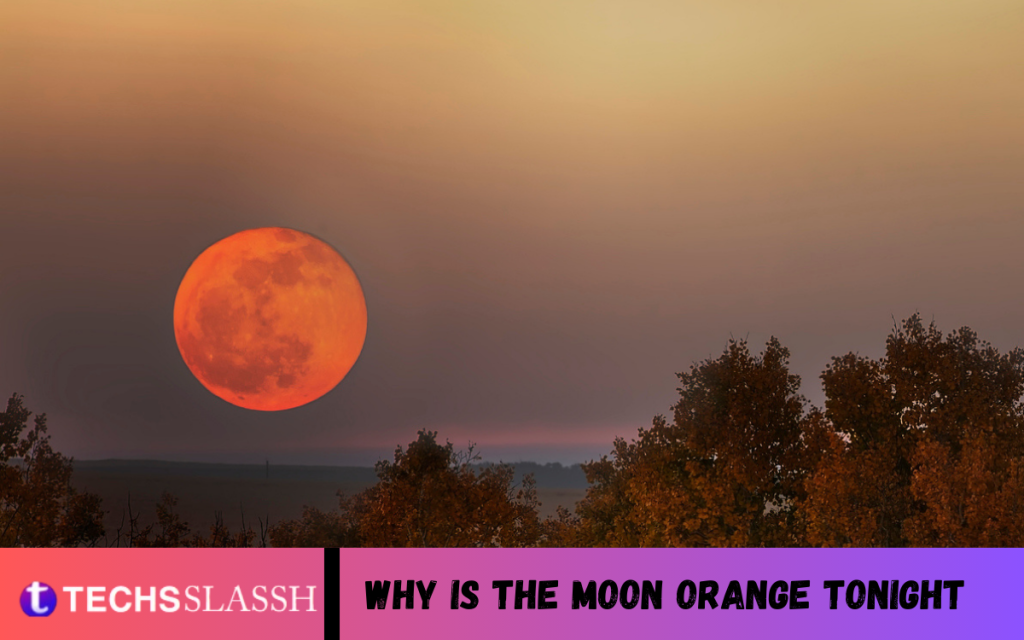Table of Contents
If You’re Looking for Why Is The Moon Orange Tonight? A peculiar sight captures the attention of stargazers worldwide: the Moon, usually radiant in its silver brilliance, takes on a mesmerizing hue of orange. This celestial spectacle, while enchanting, prompts curiosity and intrigue. What causes the Moon to don this captivating coloration? Tonight, as we gaze skyward,
The science behind the Moon’s orange glow is rooted in the intricate dance of sunlight, Earth’s atmosphere, and lunar geometry. When the Moon is low on the horizon, it appears more significant due to an optical illusion known as the “moon illusion.” As it rises or sets, Its light must traverse a denser portion of the Earth’s atmosphere. Compared to when it’s directly overhead. This atmospheric filtering scatters shorter wavelengths of light, permitting longer wavelengths, such as blue and violet. Notably red and orange, to prevail. Consequently, the Moon assumes a warm, orange hue as it rises or sets against the backdrop of the horizon.
Atmospheric conditions play a crucial role in intensifying the Moon’s orange glow. Particles and pollutants suspended in the atmosphere, particularly during periods of pollution or wildfires, can further scatter shorter wavelengths of light and enhance the Moon’s reddish tint. Thus, on nights when atmospheric conditions are ripe, the Moon’s orange brilliance becomes even more pronounced, captivating observers with its ethereal beauty.
What Is The Normal Color Of The Moon In The Night Sky?
The standard color of the Moon in the night sky is typically a shade of white or gray, often described as silver. This coloration results from sunlight reflecting off the Moon’s surface, primarily of rocky terrain and dust. The Moon’s appearance can vary slightly depending on factors such as atmospheric conditions and the Moon’s position in its orbit. However, its color remains within the white-to-gray spectrum under normal circumstances.
Why Does The Moon Change Its Color Appearance?
The color of the Moon can vary slightly due to various factors, including atmospheric conditions, the Moon’s angle in relation to the observer, and the presence of dust and particles in the Earth’s atmosphere. Under certain conditions, such as when there is significant dust or pollution in the air, the Moon may appear slightly more yellow or even reddish due to the scattering of shorter wavelengths of light.
However, when people talk about the color of the Moon in the night sky, they typically describe it as a muted, grayish-white tone resulting from the reflection of the sun’s light off its surface.
Why Is The Moon Orange Tonight?
The Moon may appear orange tonight due to a phenomenon influenced by various factors. When the Moon hovers near the horizon, its light traverses a denser layer of atmospheric particles in the Earth’s atmosphere. This atmospheric filtering scatters shorter wavelengths of light, permitting longer wavelengths, such as blue and violet, notably red and orange, to prevail. Consequently, the Moon assumes a warm, orange hue as it rises or sets against the backdrop of the horizon.
Atmospheric conditions, such as pollution or wildfires, can intensify the Moon’s orange glow by scattering shorter wavelengths of light and enhancing the reddish tint. Thus, on nights when these conditions are present, the Moon’s orange brilliance becomes more pronounced, captivating observers with its ethereal beauty.
Frequently Asked Questions
Why is the moon orange tonight?
The Moon appears orange due to the scattering of shorter wavelengths of light, such as blue and violet, as it rises or sets against the horizon. This phenomenon is influenced by atmospheric conditions and the Moon’s angle in relation to the observer.
Does the color of the Moon tonight have any significance?
While the moon’s orange color tonight is primarily a result of atmospheric effects, it holds cultural and symbolic significance across various traditions and folklore. In many cultures, the Moon symbolizes transformation, renewal, and mystery, and its unusual coloration may evoke feelings of wonder and introspection.
Can the Moon appear orange on any night, or are there specific conditions required?
The Moon can appear orange at night, but certain conditions can enhance or intensify its orange hue. Factors such as atmospheric pollution, wildfires, and the Moon’s position relative to the horizon can influence the extent of its coloration.
Is there a scientific explanation for why the Moon appears orange tonight?
Yes, the orange color of the Moon tonight can be scientifically explained by the scattering of shorter wavelengths of light in Earth’s atmosphere. The atmosphere causes shorter wavelengths to scatter and longer wavelengths, mainly red and orange, to prevail.
Will the Moon continue to appear orange throughout the night, or does its color change?
The Moon’s color may change slightly throughout the night as it moves across the sky and atmospheric conditions evolve. However, its orange hue is typically most pronounced near the horizon during sunset or moonrise.
Conclusion
The phenomenon of the Moon appearing orange tonight is a captivating spectacle rooted in scientific principles and atmospheric dynamics. The orange hue is primarily a result of the scattering of shorter wavelengths of light, such as blue and violet, as the Moon rises or sets against the horizon. This atmospheric effect, influenced by factors like pollution and wildfires, enhances the moon’s reddish tint, captivating observers with its ethereal beauty.
While the orange Moon tonight may seem extraordinary, it naturally occurs under specific conditions. However, its appearance holds more profound cultural and symbolic significance across various traditions, evoking wonder and introspection.
